Statue of Joseph Henry
Introduction
Text-to-speech Audio
Images
Joseph Henry stands in front of the Castle and looks out at the National Mall. Photo by David Bjorgen, Wikimedia.
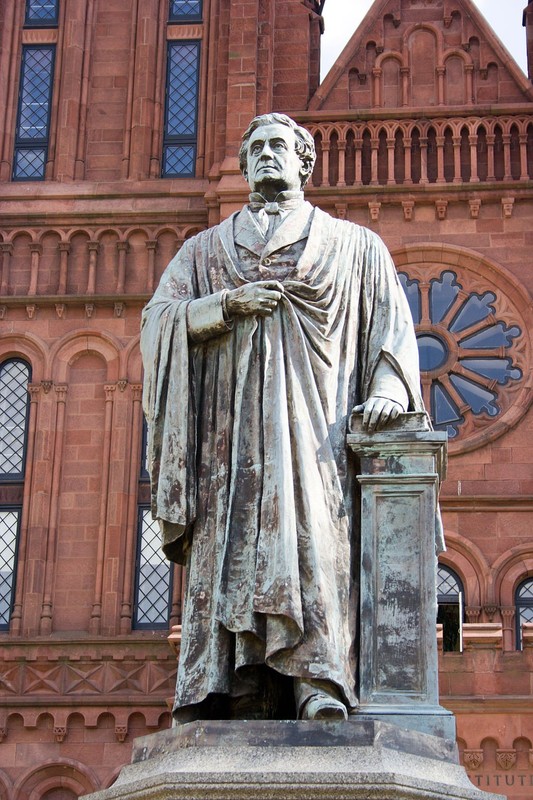
Portrait of Joseph Henry by renowned photographer Mathew Brady. Courtesy of the Smithsonian Institution Archives.
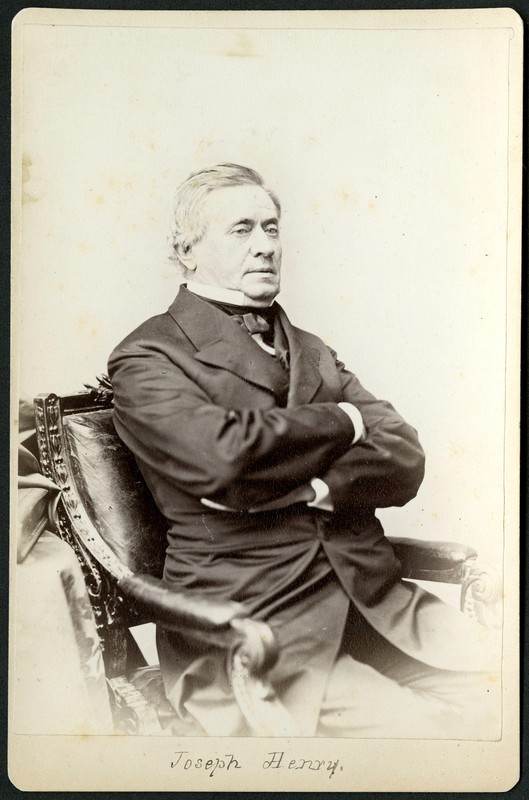
Joseph Henry's electromagnet, created by wrapping an iron bar in insulating conductive wire. Courtesy of the Smithsonian Institution Archives.
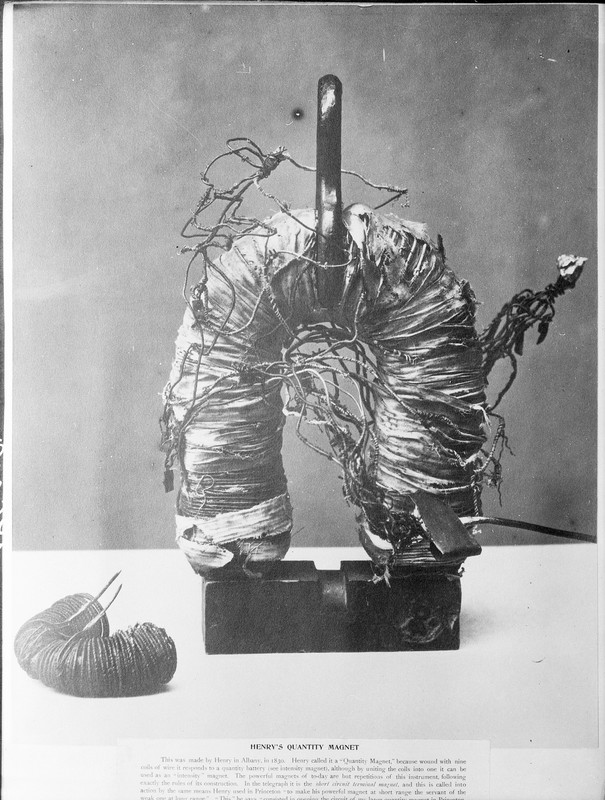
Henry, his wife Harriet, and three of their four children, Caroline, Mary and Helen, standing in the east doorway to the Castle. Courtesy of the Smithsonian Institution Archives.
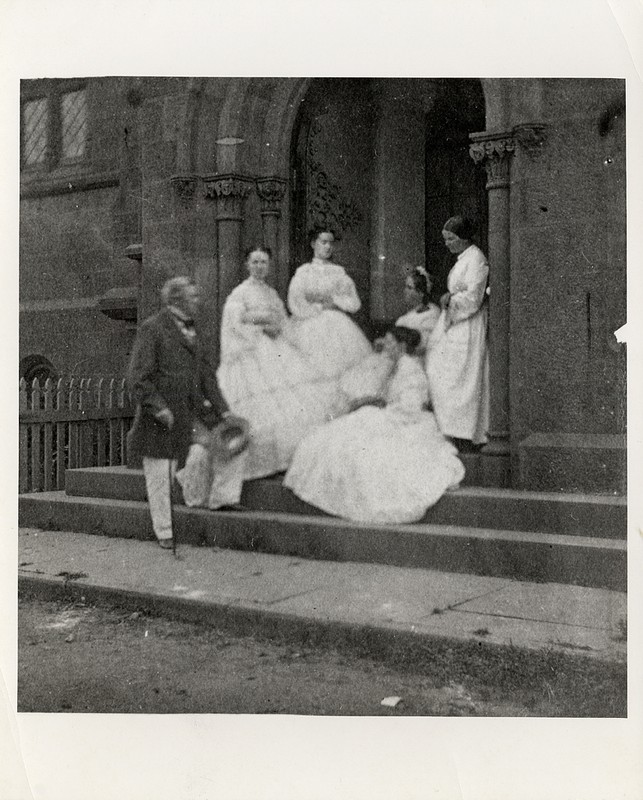
Henry, sitting behind a desk in the back, convenes the National Academy of Sciences in the Castle's Mineral Hall in 1972. Courtesy of the Smithsonian Institution Archives.
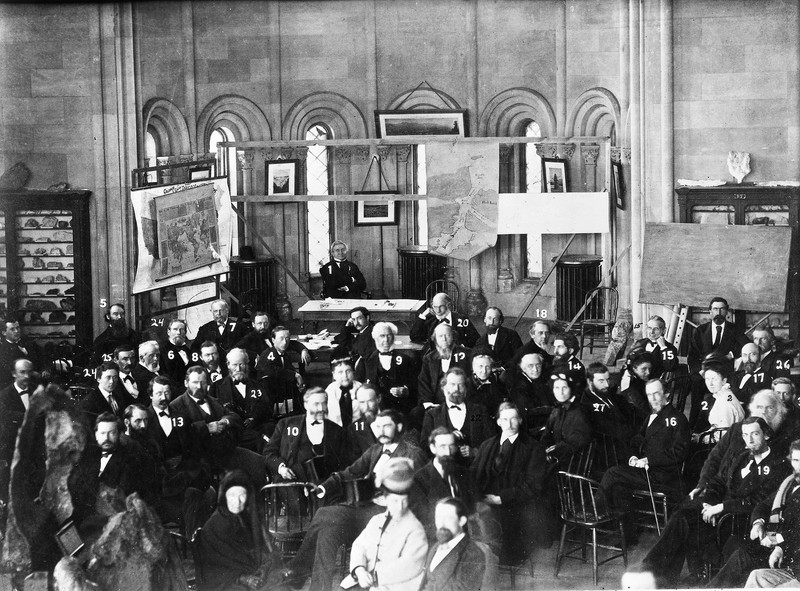
This photo, taken through a window in the Castle, captures the crowds that gathered for the Joseph Henry statue dedication in 1883. Courtesy of the Smithsonian Institution Archives.
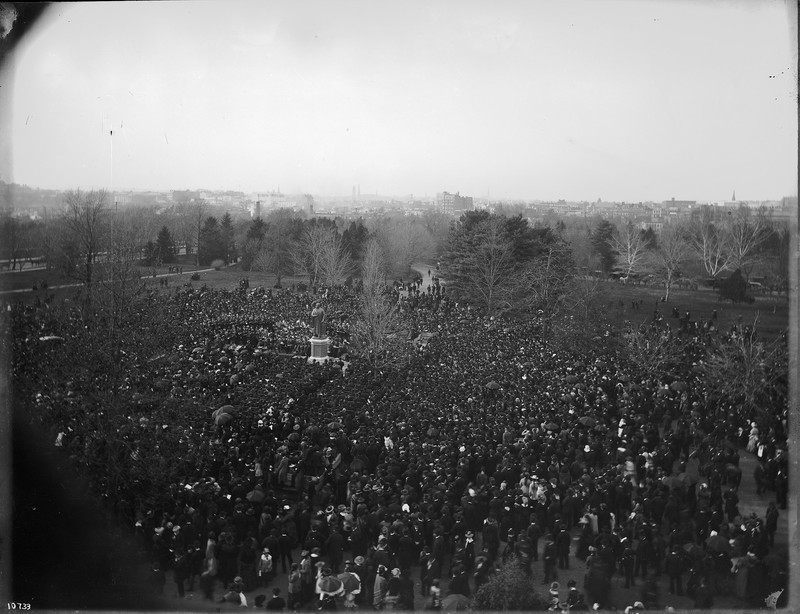
The Joseph Henry statue looks toward the Castle, the place Henry worked and called home until the end of his life. Courtesy of the Smithsonian Institution Archives.
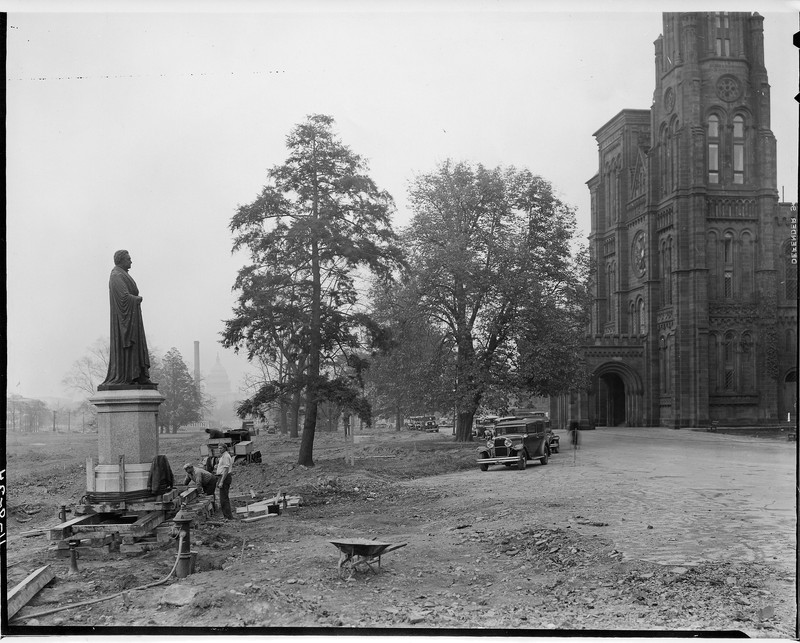
In 1965, the Joseph Henry statue was turned outward, so that he symbolically faced the Smithsonian museums that followed in his footsteps. Courtesy of the Smithsonian Institution Archives.
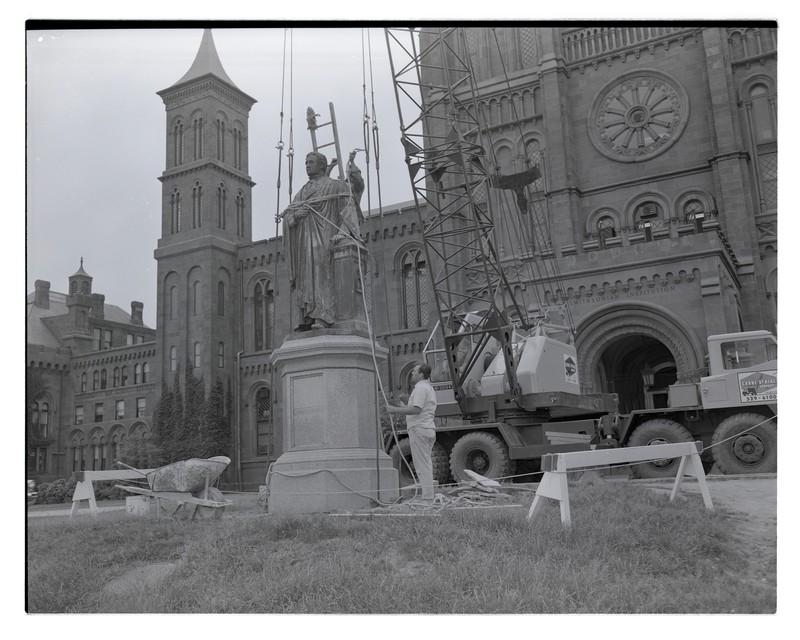
Backstory and Context
Text-to-speech Audio
Born to a modest family in Albany, New York, in 1797, the young Joseph Henry worked nearly missed attending college due to finances. After coming upon the popular Lectures on Experimental Philosophy, Astronomy, and Chemistry (1808) by George Gregory, Henry felt called to pursue scientific research. He entered Albany Academy at the age of 21 and received a professor position there a few years after graduating. From 1832 to 1846, Henry began a career at the College of New Jersey, now Princeton University, and taught popular courses in natural philosophy, geology, and architecture. Henry built a name for himself within the scientific communities of the United States and Europe. He developed the most powerful electromagnets of the time, using iron bars wrapped in metal coil to generate energy. His discoveries led him to experiment with electric motors, the telegraph, and the telephone. He also studied optics, acoustics, astrophysics, fluid dynamics, molecular forces, and terrestrial magnetism, making him a well-rounded intellectual.
In December 1846, the Smithsonian Board of Regents selected Henry as the first Secretary of the Smithsonian Institution. Henry and his wife, Harriett, and their four children moved from Princeton to Washington, D.C. and made their home in the private residence of the newly-constructed Castle. Henry did not particularly like Washington, D.C., preferring the pace of college towns and rural areas, and initially disapproved of Smithsonian dollars going toward brick-and-mortar projects like the Castle. He also lamented the heat and humidity of Washingtonian summers, writing that “the thick walls of the [Smithsonian] building become like the sides of an oven sufficiently hot to cook whatever they may enclose.”1 When he had the opportunity, he escaped to less punishing environments where he could conduct research, his most fundamental passion. His dedication to science and culture put the Smithsonian Institution on an important path for the “increase and diffusion of knowledge.”
In his tenure as Secretary of the Smithsonian, Henry set a precedent for the position and the entire Smithsonian Institution. His “Programme of Organization,” adopted in 1847, created a guide for developing the Smithsonian Institution’s mission and values. He laid out research and educational initiatives including research expeditions, publications, collections, a museum, and a library, all of which emphasized science, history, anthropology, and art. Under Henry, the Castle welcomed the public to view exhibits and hear lectures. He oversaw numerous projects such as the Smithsonian Meteorological Project, which developed a pattern of recordkeeping that later transformed into the National Weather Service. Outside of the Smithsonian Institution itself, Henry’s scientific network expanded as did his influence. He founded and led the National Academy of Science and was an active member of the Philosophical Society of Washington and the Light-House Board.
The Civil War put a strain on the Smithsonian’s resources, as with the rest of the United States government, challenging Henry to continue scientific advancement amid hardships. He served as a science advisor to President Abraham Lincoln, assisted the Union Army with establishing a balloon corps, and worked with the Sanitary Commission and Surgeon-General of the U.S. Army to better understand physical, mental, and emotional wellbeing of soldiers. In 1865, an accidental fire destroyed much of the Castle, including exhibitions, a lecture room, a laboratory, and Henry’s office containing his papers, letters, diaries, and reports. Henry’s daughter, Mary, called the event “one of the momentous and saddest events of lives.”2 In the following days, Henry moved the surviving collections and initiated efforts to repair the building. After the Civil War, more permanent repairs were completed and the building reopened to visitors.
While still serving as the Smithsonian Secretary, Henry died on May 13, 1878, after months of suffering from Bright’s disease, a historical description of kidney disease. His funeral was compared to the fanfare of Abraham Lincoln’s and he was laid to rest in Oak Hill Cemetery in D.C. In his memory, Congress passed an act to create a statue of Henry. The bronze statue designed by William Wetmore Story was erected on the National Mall grounds in 1883. Thousands attended the dedication ceremony, where John Philip Sousa conducted the Marine Band’s first public performance of “The Transit of Venus March." The statue stands nine feet tall and features Henry leaning against a pedestal where there is a relief of a horseshoe-shaped electromagnet. A unit of induction is also named “the Henry” in his honor.
In 1965, in honor of the Bicentennial Celebration of James Smithson’s birth, the Joseph Henry statue was turned to face the National Mall. He forever looks upon the numerous Smithsonian museums that followed him. In the words of former Secretary I. Michael Heyman, Joseph Henry “successfully steered the Institution through many contentious and divisive issues during its nascent years, setting the course for the great complex of museums and research facilities we have today.”3
Sources
1. Smithsonian Institution, “Joseph Henry: A Life in Science,” Smithsonian Institution Archives.
2. Smithsonian Institution, “Joseph Henry: A Life in Science,” Smithsonian Institution Archives.
3. Heyman, I. Michael. “Joseph Henry’s Legacy.” Smithsonian Magazine.
Henson, Pamela. “The Burning of the Smithsonian.” Smithsonian Institution Archives. January 23, 2015. Accessed October 2017. https://siarchives.si.edu/blog/burning-smithsonian
Heyman, I. Michael. “Joseph Henry’s Legacy.” Smithsonian Magazine. December 1997. Accessed October 2017. https://www.smithsonianmag.com/history/joseph-henrys-legacy-147074473/
Kurin, Richard. https://www.smithsonianmag.com/smithsonian-institution/devastating-fire-nearly-consumed-smithsonian-castle-1865-180954002/
Smithsonian Institution. “General History.” Smithsonian Institution Archives. Accessed October 2017. https://siarchives.si.edu/history/general-history
Smithsonian Institution. “Joseph Henry, 1797-1878.” Smithsonian Institution Archives. Accessed October 2017. https://siarchives.si.edu/history/joseph-henry
Smithsonian Institution. “Joseph Henry: A Life in Science.” Smithsonian Institution Archives. Accessed October 2017. https://siarchives.si.edu/history/featured-topics/henry/joseph-henrys-life
Smithsonian Institution. Record Unit 7001, Henry, Joseph, 1797-1878, Joseph Henry Collection, 1808, 1825-1878, and related papers to circa 1903. Accessed October 2017. https://siarchives.si.edu/collections/siris_arc_217201
Smithsonian Institution. “Smithsonian Institution Building, The Castle.” Smithsonian Institution Archives. Accessed October 2017. https://siarchives.si.edu/history/smithsonian-institution-building-castle
Images:
“Statue of Henry.” Photo. 2005. David Bjorgen. Wikimedia Commons. Accessed October 2017. https://en.wikipedia.org/wiki/Joseph_Henry#/media/File:JosephHenry-SmithsonianCastle-20050517.jpg
“Joseph Henry.” Photo. 1860s. Mathew Brady. Smithsonian Institution Archives Record Unit 95, Box 27B. Accessed October 2017. https://siarchives.si.edu/collections/siris_sic_6949
“Joseph Henry’s Albany Magnet.” Object. 1820s. Smithsonian Institution Archives, Accession 11-006. Accessed October 2017. https://siarchives.si.edu/collections/siris_sic_13157
“Henry Family at East Door of Castle.” Photo. 1860s. Smithsonian Institution Archives, Record Unit 95, Box 12, Folder: 3 Accessed October 2017. https://siarchives.si.edu/collections/siris_sic_5596
“National Academy of Sciences Meeting, Smithsonian Institution Building.” Photo. 1870s. Smithsonian Institution Archives, Record Unit 95, Box 28, Folder: 22. Accessed October 2017. https://siarchives.si.edu/collections/siris_sic_9834
“Statue of Joseph Henry Commissioned.” Photo. 1880s. Smithsonian Institution Archives. Accessed October 2017. https://siarchives.si.edu/collections/siris_sic_662
“Dedication of Henry Statue.” Photo. 1880s. Smithsonian Institution Archives, Record Unit 95, Box 56, Folder: 3 Accessed October 2017. https://siarchives.si.edu/collections/siris_sic_9691
“Turning of the Joseph Henry Statue.” Photo. 1960s. Smithsonian Institution Archives, Record Unit 157, Buildings Management Department Records, Image #SIA2012-3606. Accessed October 2017. https://siarchives.si.edu/collections/siris_arc_385034
